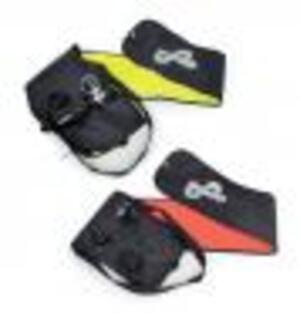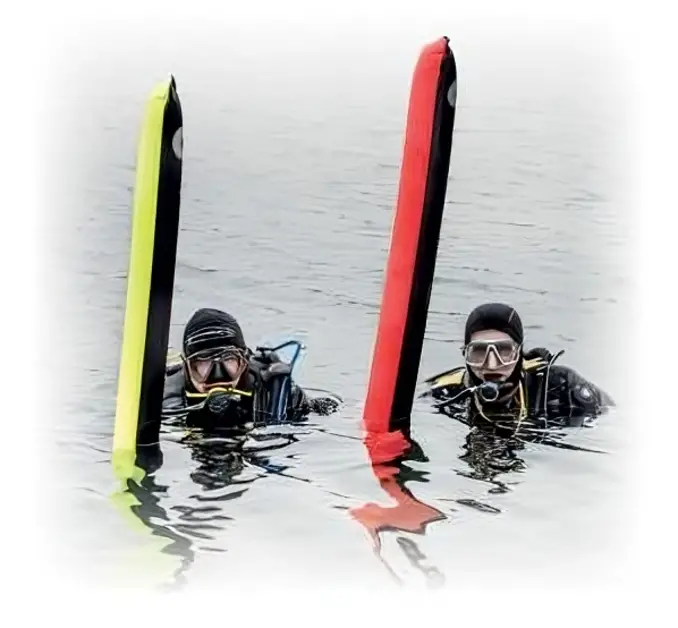BEING SEEN AT THE SURFACE is one of the most important factors in diver safety. Indeed, ascending away from a shotline can be a hazardous affair, especially in UK waters.
The attendant dive-boat skippers need to see where all of their divers are from their ascent phase to pick-up.
There is no easier solution than the humble delayed surface marker buoy (DSMB). Colour is the crucial factor.
Surface conditions can change from minute to minute, and sea water reflecting a changing sky can make the surface appear white, grey, green, blue or even black.
Extensive research has established that orange is the best color to be easily spotted against a dark surface, while black stands out on a white or grey surface.
Cornwall-based Ambient Pressure Diving has listened to my pleas for a perfect solution and has now produced its popular DSMB range in a black bi-color scheme.
The Design
A DSMB is no more than an inflatable, brightly coloured nylon tube with a polythene liner, and the best of them “self-seal” when filled.
Inflation methods vary from exhaust regulator gas to small charged cylinders.
SMBs are ideally deployed before the ascent phase of a dive or deployed at the start of a drift dive. Attached to a reel and line, they link the diver to the surface so that the boat crew can follow their progress.
APD has been making DSMBs for decades, and refining its models based on feedback from the people who use them, UK divers.The
result today is a range that’s fit for purpose. These DSMBs are around 1.3m long, with a diameter when inflated of 20cm.
A self-sealing baffle system within the polythene lining keeps them inflated even if they lie flat on the water surface.
A pull-dump also acts as an over-inflation release valve to ensure that the whole thing doesn’t rupture when over-filled on ascent as the gas expands due to reduced ambient water pressure.
The dump also allows for rapid deflation in an emergency, or prior to stowing.
A webbing loop sewn onto the bottom section allows for reel-line connection.
There are three inflation options. Standard on all models is a means to fill the buoy through the open base using gas from a spare regulator, a nozzle attached to a spare low-pressure hose, or exhaust gas from your primary second stage.
A second option is to fill it via APD’s Easifil adaptor. This has a BC- or drysuit-style male low-pressure hose connection without a locking groove, to prevent the hose from becoming attached when in use.
Lastly there is the option to fill the buoy from a 0.1-litre 232-bar mini-cylinder, an ideal solution for rebreather divers.
A stainless-steel eyelet is fitted to the tip of the buoy to attach a small strobe, chemical-stick light, message slate or ID marker.
Charging the Mini-Cylinder
Once the charged mini-cylinder valve is opened under water, the buoy will instantly inflate and ascend to the surface, and the valve will obviously remain open until the dive is completed.
But this means that should any sea water enter the DSMB, it can also enter the open cylinder.
When next decanting air from a main dive-tank the pressure will equalise, and if the mini-cylinder is inclined in a downward-facing position with both valves open, the caustic salt water can drain into the main cylinder and cause unseen corrosion, damaging, sometimes terminally, the inside of the main tank.
If using this DSMB inflation method, it’s imperative that the mini-cylinder is inclined so that its base is below both of the valves when decanting air.
Colours

There is no standard when it comes to DSMB colours, although quite a lot of technical-diving clubs and groups have adopted a procedure that involves the deployment of an all-yellow buoy in an emergency.
They will have previously supplied a bail-out tank along with a regulator set and briefed the boat-skipper on the actions to take if a diver puts up a yellow buoy with a slate message detailing the emergency.
An all-yellow buoy is claimed to be more visible from the air should a search and rescue helicopter or spotter plane be deployed.
Boat-skippers, however, generally favour a fluorescent orange or red buoy, because this can be seen easily from sea level against a water surface that’s reflecting a blue sky, whereas black is very distinctive against water that’s reflecting a white overcast sky.
Combining black with bright colors, as this new APD marker buoy does, can make it easier to spot in almost all lighting conditions.
Conclusion
An air-filled nylon tube is as lo-tec a device as you can get, but this is such an important piece of safety equipment and needs to be right.
It makes sense to maximise the chances of you being spotted at the surface by choosing a DSMB that’s simple to deploy and easy for your skipper to see at a distance.
I take two DSMBs and reels with me on every UK dive, and see them as essential personal protective equipment.
These new black bi-colour DSMB are possibly the best around, and with their visibility and options for inflation will certainly contribute to safer diving.
PRICE: Standard self-sealing £32. Easifil £60. Mini-cylinder £110
DIMENSIONS: 130 x 20cm
COLOURS: Black/red. Black/yellow
CONTACT: Ap Diving website

